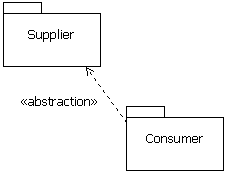Abstraction Relationships
An abstraction relationship is a type of dependency relationship that relates two model elements (or sets of model elements) that represent the same concept at different levels of abstraction or from different viewpoints. In most cases, one of the model elements is more detailed than the other one. The more detailed model element is the consumer in the relationship, and the less detailed model element is the supplier. Types of abstraction relationships include derivation, realization, refinement, and trace relationships. All types of abstraction relationships can connect model elements that are in the same model; realization, refinement, and trace relationships can also connect model elements in different models. For example, if you develop an analysis model and then a design model, you can connect them with a trace relationship pointing from the analysis model to the design model to indicate that the design model provides a different level of abstraction about the same system.Connector An abstraction relationship appears as a dashed line with an open arrow. It points from the consumer model element to the supplier model element. When you first create an abstraction relationship, the «abstraction» keyword appears next to the connector.

You should assign a stereotype to the abstraction relationship to indicate the type of abstraction.
Types of Abstraction Relationships The type of abstraction is defined by a stereotype. The following table identifies the predefined stereotypes for abstraction relationships.
| Name | Keyword | Description |
| Derivation | «derive» | Indicates that a consumer model element, such as a constraint, contains the details or formula for computing a derived model element (the supplier). For details on derived model elements, see Specifying Derived for Attributes and Associations. |
| Realization | «realize» | Indicates that the supplier model element provides a specification that the consumer model element implements. |
| Refinement | «refine» | Indicates that the consumer model element represents a more developed specification than the supplier model element. |
| Trace | «trace» | Indicates that the consumer model element is a historical development of the supplier model element. |
Using Abstraction Relationships You can add abstraction relationships to your model to indicate the following:
- Derivation abstraction relationships connect constraints that detail a derivation to the derived model element. You can also use a constraint attachment relationship to connect the constraint to the derived model element.
- For details about using realization relationships, see Realization Relationships.
- Refinement abstraction relationships indicate iterative development, optimization, and transformations between the model elements that they connect.
- Trace abstraction relationships track requirements and changes across models.
Related Topics
- Adding Abstraction Relationships
- Adding Realization Relationships
- Dependency Relationships
- Keywords
- Stereotypes
Comments (
 )
)
 )
)
Link to this page:
//www.vb-net.com/dotnet/relation/Abstraction.htm
|
|